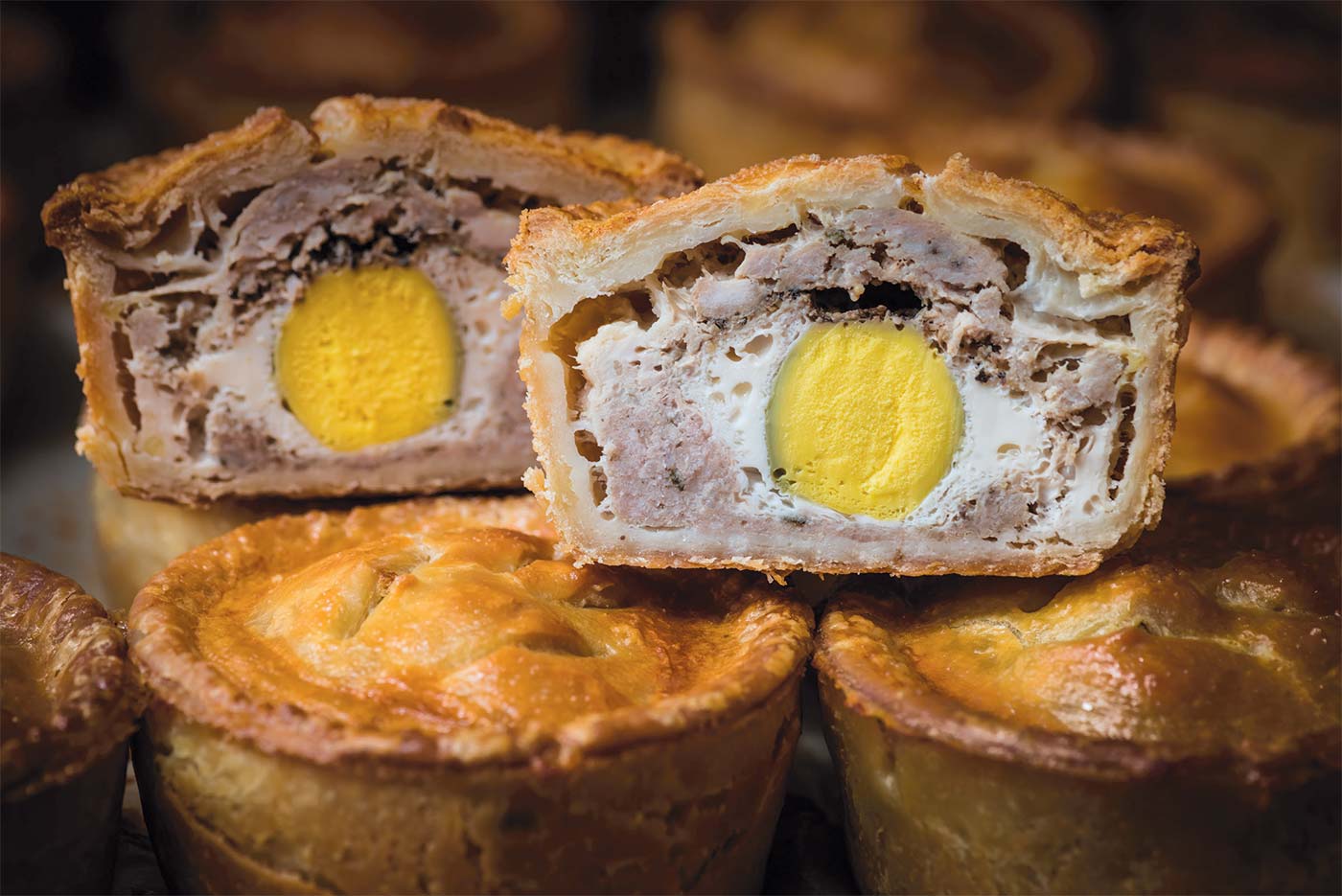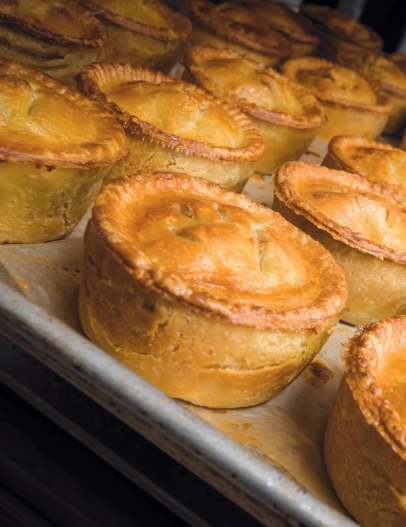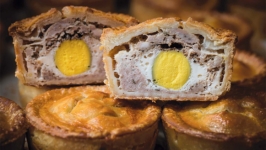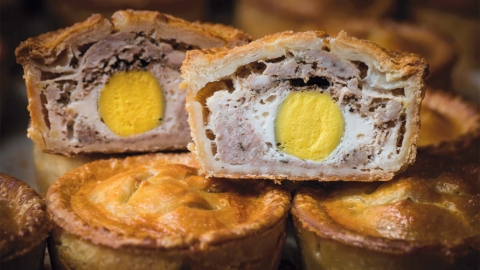Savoring Pie at Burbelmaiers in Ocean Grove
At Bürbelmaiers, one might be forgiven for thinking that teleportation has become a reality. Every bit the proper British pie shop, the cozy space would be as at home in London or Leicester as it is in its column-lined storefront in Ocean Grove. As it happens, science fiction plays a role in the shop’s origin story. The experience of a “Star Trek moment,” to be exact.
Well before pies became his culinary muse, Chef Peter Burbela worked as an NJIT-trained project manager for a mechanical engineering firm. The job may have suited his left-brain skills, which later would be translated into his old-world-meets-new culinary ethos, yet it left him unfulfilled. Burbela, an avid home cook, would escape into the realm of cookbooks.
“It’s Saturday night, two or three o’clock in the morning, and I’m sitting there with Jacques Pepin and Julia Child,” Burbela recalls. Poring over recipes, he pondered how he might translate them if he were to helm a restaurant. One such night, a vintage television rerun enticed him to take that thought experiment a step further.
“There was this old episode from the original Star Trek, ‘The Trouble with Tribbles.’ They were supposed to be having an R&R break, and Kirk and Spock walk into this conference room and Scotty is at his terminal.” In the episode, Kirk comments on the fact that Scotty, lieutenant commander of the Enterprise, is elbow deep in a technical manual, at odds with his missive to relax. Burbela smiles as he narrates. “And Scotty looks up at him with a big grin on his face and says, ‘Aye, Captain. I am relaxing!’”
It sparked a revelation.
“I realized I would never find myself looking at an engineering manual or doing differential equations for relaxation or enjoyment,” Burbela says. “Yet I had this passion where I’m sitting there at two or three o’clock in the morning looking at cookbooks and coming up with my own methods. To be successful at anything in life, you have to spend a lot of time. And if you have to spend a lot of time, you should be doing it with something you really love.”
Fast forward to a stint at American Fare in Maplewood, after which Burbela opened Terra, also in Maplewood, followed by Peter’s in Vieques, Puerto Rico. Moving from office to professional kitchen, Burbela was free to redirect his inquisitive mind toward more captivating pursuits.

Courtney and Peter Burbela
“I feel like we’re up here to tell people [about savory pies]. To liberate them from their sandwich rut.”
INSPIRATION ROOTED IN MEMORY
As the chef honed his craft, an opportunity arose to create charcuterie for Brick Farm Market when it opened in Hopewell in 2013. There was one problem: The facilities were not yet ready.
Undaunted, Burbela pondered alternatives. “I thought, you know what, I’m going to make pork pie,” the chef says. This wasn’t merely a lark. Burbela is the child of a Ukrainian father and British mother from Yorkshire; travels to England were part of his upbringing. “I first went to England with my mom, many moons ago. The first time, I was five, I would say. And I always loved the pork pie.” Crafted with a hot-water crust, the pies reportedly date back to the late fourteenth century and were traditionally filled with minced pork and pork jelly.
Here, it may be helpful to highlight a few distinctions between British and American pie traditions.
If you say the word “pie” in the States, visions of sugarplums underscore a key difference. Where American pies are typically fruit-meets-sweet affairs, British versions are historically savory. Burbela’s wife and business partner Courtney (née Maier) explains: “Before there was Tupperware, there were pies. They would take dough, put some sustenance in it, seal it, wrap it in a cloth and take it into the fields, because you didn’t just pick something up on the way.”
The pie’s key value, in other words, was portability. The crust was typically torn away and discarded. “The dough keeps the air away from the meat, and then the filling keeps the dough kind of moist. It’s this perfect container, and the original fast/slow food.”
Filled pies made with flour-and-oil-based dough are said to trace to the Romans, though prototypes go back to ancient Egypt. Pies have been in vogue in Britain since Medieval days, likely inspired by a Northern European method of encasing fillings in dough for sea voyages. Early British pies were borne of an era when sugar was a pricey treat reserved for the elite. Pies, then, were a savory proposition. Only in the mid 1500s did fruit pies enter the British canon, along with those including edible crusts.
“When you start to dig into the history of these things, it’s really fascinating,” Burbela says. “Look at the mid-1800s and the birth of the pork pie. They were originally done for the serving class. The crust was inedible, and they just threw that away and ate the filling. Then, when the monied gentry came along, they were like: ‘These are fascinating. I love these.’ The crust started to be elevated.”
In her mystery-history piece “Death in the Pie,” published in the winter/spring 2019 edition of Eaten: The Food History Magazine, Dressler Parsons tracks pie’s stateside arrival to the Colonial era. “The dish first landed in the American colonies with the pilgrims, who used English-style meat pies with often edible crusts as a means to preserve the food inside,” she writes. “Recipes for these edible treats expanded and multiplied, and over 150 years later, Amelia Simmons’ American Cookery (1796), what many historians consider to be the first American cookbook, lists a variety of meat pies and two sweet pies—apple and currant.”
Burbela is fascinated by the transformation. “It didn’t become something that’s a sweet dessert until Victorian days, when sugar became affordable,” he says, the result of widespread cultivation in the Mediterranean and Atlantic and the dark history of the slave trade. Sugar took over in the American imagination.
This American propensity toward sweetness explains a divergent response when customers first walk through the doors of Bürbelmaiers. “[The concept of savory pie] confuses a lot of folks. They’re just thinking of a big old cherry pie,” Burbela says.
This is where Courtney Burbela—an art marketing consultant by trade who developed Bürbelmaiers’ cheeky visual aesthetic—comes in. In the front of the house, she and her team have fun welcoming relieved expats. “There are some people who come in and say, ‘Every time we hear pie shop, we get excited and walk in and it’s like, oh . . . it’s not a pie shop. This is actually a pie shop!’” She smiles. Customers of a certain generation also recount tales of buying Scottish mutton pies as kids in Kearny.
The power in honoring such memories is underscored by first-time customer Kathleen Manhardt of Spring Lake, who was savoring a sauerbraten pie at the shop’s communal table on the day of Edible Jersey’s visit. “My mother was German, and she made the most delicious sauerbraten that was passed down from generation to generation,” she mused. “There are very few places you can get good sauerbraten anymore. Really. Well, I feel like I had my mother’s.”
For all of the love from those in the know, the biggest job involves guiding first-timers through a roster of palm-sized, savory pies that runs nearly two dozen deep. Courtney Burbela views it as a matter of education. “They’ll come in and be like, ‘where are the pies?’ ‘Are these muffins?’ Mostly, I feel like we’re up here to tell people [about savory pies]. To liberate them from their sandwich rut.”
 Early British pies were borne of an era when sugar was a pricey treat reserved for the elite. Pies, then, were a savory proposition.
Early British pies were borne of an era when sugar was a pricey treat reserved for the elite. Pies, then, were a savory proposition.
PIES FOR EVERY PALATE
Certain pies get frequent billing, from a spin on Leicestershire pork pies to beef and mushroom and pork and stilton— a.k.a. the Blue Piggy. There are also vegetarian options, including tomato-feta. Yet, as much as he revels in the classics, Burbela likes to get creative. Think Cubanos. Cassoulet. Sloppy Joes. Philly cheesesteak.
“One time, I had a coq au vin pie. Well, we had gone out and had coq au vin. I’d always done coq au vin in fine-dining days. A lot of these have come about from: ‘How can I turn that into a pie?’ It’s a platform to jump off of. It really gives you flexibility to take your own food curiosities, your own food loves, and put it in a formula.”
Tellingly, it took a year and a half after opening in 2016 for chicken pot pie to make the menu. “I want them to know what the place is,” Burbela says, referring to the shop.
A succinct answer to that query: Bürbelmaiers is a labor of love. Baked to golden and arranged in a tempting display case, a given pie can involve days of work. Slow braises bubble, while a Robot Coupe makes swift work of pommes puree. Curries are built from sizzling plates of herbs and seeds, while an immersion circulator brings ingredients to temp.
One decidedly old-school piece of equipment is the pie press, a gorgeous relic from John Hunt Bolton in Manchester, England. The owners call her Vicky, a nod to her Victorian aesthetic and gorgeous curves. “The castings were probably done in the late 1800s or early 1900s. And yet even that is modernized a little bit. The dies have heating elements on them, which make an easier release. And there’s also an air valve. When you pull the die back up, that tiny bit of air keeps the pie shell down.”
Burbela does offer a few sweet pies. Just don’t ask for blueberries in spring. “You know when people want apple pie? July. I’m like, do you realize apple season is September, October, November?” he says, noting that American pies are often quite processed. Not so, here. “The integrity of the food is really important to me: using those old techniques, using the real ingredients and then infusing them with a little bit of modern technology,” Burbela reflects. “It’s bringing it back to a tradition of something real.”
BÜRBELMAIERS
69 Main Ave., Ocean Grove
732.774.3674
burbelmaiers.com
- Bürbelmaiers stocks a curated selection of British pantry staples, along with cold-smoked olive oil and other treats. Watch for communal dinners outside of the summer high season.
DON'T FEAR THE PIE CRUST!
Would-be pie makers are often held back by fear. Have faith. Burbela recalls his first savory pie, a Cornish pasty from his mother's mid-century Be-Ro cookbook, put out by a British self-rising flour company “Looking back, it was awful. I didn't really know what I was doing yet. But it shows you: Sometimes you need to just not be scared.” Here, tips for the home baker;
- Keep calm and bake on. Burbela says the path to pie mastery all comes back to advice from Julia Child: “Don't panic. Keep going. Don't fear it. Just put the love in.”
- Embrace tech. “Your best friend in making a really great crust is a food processor. Pulse, pulse, pulse, pulse, pulse. Add a little water in. Let it rest. James Beard was an early proponent of the Cuisinart. He said: ‘I would buy a food processor just to do crust.’”
- Seek inspiration. “For people who want to learn a little about baking, watch The Great British Bake Off. Some of them are train wrecks, and some of them are quite brilliant.”
- Practice makes delicious. “Put it together. It looks like a pile. Let it rest. By the time you roll it out, it's going to be this wonderful flaky crust. Dive in, don't fear If it's not perfect, it will be delicious. Try it again later. The butter is what makes it good.”








